| PICTURE FRAMING: STANDARD SIZES AND GENERAL GUIDELINES |
 |
|
This useful guide is intended to answer all your questions about standard frame and paper sizes, canvas print guidelines, general guidelines about window mats, the how and why of different hanging hardware, and basic thicknesses of frame content materials.
|
SUMMARY
| STANDARD FRAMES |
Department and craft store frames come in a variety of standard sizes. Many of these options have a window mat as well, which offers space for two sizes: one with the mat, and one without. (ie: 8x10" and 5x7") |
| FLOATER FRAMES |
Floater frames border canvas prints, original paintings, thick plaque mounts, and wood block prints. They are constructed to allow space between the outside of the artwork and the inside of the frame. There are three different styles of floater frame. |
| STANDARD POSTER FRAMES |
Both posters and their frames come in a few standard sizes. These frames are generally plain and slim, without a mat. For non-standard poster frame styles or sizes, a custom order will be required. Mats may not be available for sizes larger than 28x36" |
| STANDARD PAPER SIZES |
North American standard paper sizes include letter, legal, and tabloid. The International Organization for Standardization (ISO) identified the A-series. Standard paper sizes are useful to know for framing important documents. |
| CANVAS PRINT GUIDELINES |
Canvas prints are available in a number of depths, 3/4" and 1-1/2" being standard. The size of the print will determine the recommended stretcher bar depth. In general, smaller canvases will be 3/4" while larger ones will be 1-1/2". 2-1/2" is also avaialbe for a more dramatic depth. |
| HANGING HARDWARE |
Different types of hanging hardware are suitable for different pieces, depending on dimensions and weight. Hardware should be affixed 1/3 to 1/4 of the total height from the top, and hanging wire should be securely fastened to each hanger. |
| CONTENTS OF FRAME |
The thickness of the frame contents - which includes the glazing (glass or acrylic), mat, artwork, and backing - should be slightly less than the frame's rabbet depth to allow space for securing the contents in the frame. |
|
| STANDARD FRAME AND MAT SIZES
|
 |
|
Standard frame sizes (8 x 10", for example) are those you can find in your local craft or department store. While custom frame businesses are more often called upon to create uncommon sizes (such as 19.5 x 22"), they are also a useful source for frame face widths you might not find down the isle, such as an 8 x 10" frame that is 4" wide.
Many standard frames also come with a mat. This allows the buyer to use the frame as two different sizes: one larger size without the mat, and a smaller size with the mat in place. An 8 x 10" standard frame may come with a 1-1/2" mat, which allows you to frame a 5 x 7" image as well.
NOTE: The mat opening will be slightly smaller than the suggested picture size. This allows the mat to overlap the image slightly, holding it behind the frame. Generally, the mat will cover 1/4" on each side of the image. So, a mat for a 5 x 7" picture will have an opening of 4.5 x 6.5".
Standard Frame and Mat Sizes in Inches
| FRAME SIZE |
MAT OPENING |
Alternate Picture Size |
| 8 x 10 |
4.5 x 6.5 |
5 x 7 |
| 11 x 14 |
7.5 x 9.5 |
8 x 10 |
| 16 x 20 |
10.5 x 13.5 |
11 x 14 |
| 20 x 24 |
15.5 x 19.5 |
16 x 20 |
| 24 x 36 |
19.5 x 29.5 |
20" x 30 |
| 30 x 40 |
21.5 x 31.5 |
22 x 32 |
|
There are other important measurements for frames, besides the dimensions. You may want to know the face width, rabbet depth, or overall depth. When you order a custom picture frame you will see all these measurements outlined in a graphic within the order page.
DIMENSIONS AND FRACTIONS
When measuring the artwork dimentions for ordering a custom frame, it is important to record very exact measurements, down to 1/16 of an inch. These specifics can be recorded as fractions or decimals (for instance: 7.75 x 9.75 or 7-3/4 x 9-3/4):
- 1/16 = 0.0625
- 1/8 = 0.125
- 1/4 = 0.25
- 3/8 = 0.375
- 1/2 = 0.5
- 5/8 = 0.625
- 3/4 = 0.75
- 7/8 = 0.875
|

Standard frame and mat pairs offer two size options

This graphic is shown on each frame's order page
|
| MORE ON MATS
|
 |
|
There are many things to consider when choosing a mat for your frame. You must select the best shade (there are hundreds of "whites" out there), the best depth, the best width - and this is determined by both the frame and the artwork. You must decide if you want a double or triple mat, a French Cut mat, or a textured mat.
If you have purchased a less expensive standard frame, the mat within may be low quality. It is also possible you require that frame size but a different mat opening. In that case, we are happy to cut a custom mat to fit in your standard frame. Place your order from our Custom Cut Matboards page.
For more information on these different choices, you can read these articles:
Measuring for a Mat
Choosing the Best Mat Color
Choosing a Mat Size
All About Mats
Though matboard is available in hundreds of colors, a white mat is the most common choice. One of those many different shades is bound to work with your photograph or artwork. And if it doesn't, extending your search to grays and creams will generate a suitable result.
BOTTOM WEIGHTING
A quick note on bottom weighting, which is discussed in more detail in Choosing a Mat Size.
Bottom weighting is the traditional mat style practice of making the bottom arm of the mat slightly wider than the other three. The style originated when artwork was hung high on the wall, tilted down. An optical illusion created when the viewer was gazing up made the bottom arm of the mat appear thinner, though it was the same size. To compensate, the framer would make that arm 10-20% wider.
Today, most art is hung at eye level, and the optical illusion is a thing of the past (some some museums). Some framers may encourage the style, while others have moved away from it, but the choice to bottom-weight is entirely at the discression of the buyer. If the correlation between the frame size and the image size means even measurements on all sides is not possible, bottom-weighting is a way to avoid disparate dimensions.
(For instance: if you are fitting a 10 x 11" image into a 16x20" frame, you can avoid a mat that is 2" on the sides and 2.5" on the top and bottom by making the top and sides 2" and the bottom 3".)
|
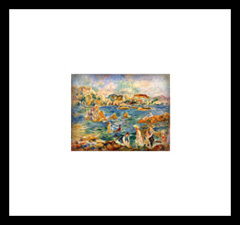
Evenly-weighted mat border
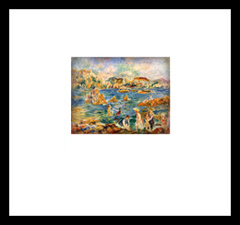
Bottom-weighted mat border
|
| FLOATER FRAME STYLES
|
 |
|
Floater frames are a relatively new convention in the long history of picture framing. Primarily used for stretched canvas or wood block artwork, they are also an option for plaques and rectangular ceramic or clay reliefs.
Because the floater frame overlap the artwork from behind rather than in front (like the lip of a traditional frame), the arrangement of the pieces differs slightly. A floater frame is cut to be slightly larger than the dimensions of the canvas, so there is a gap between the outside of the art and the inside of the frame.
Stair Step and Tapered floater frames force this gap, while the L-shaped variety must be deliberately cut wide. As you can see from the images at the right, the two former frames will touch the sides of the canvas, while the latter does not. Regardless of the style, the standard gap between a floater frame and the canvas is 1/4".

Stair Step Floater Frame
|

Tapered Floater Frame
|

L-Shape Floater Frame
|
|
|
| POSTER SIZES AND FRAMES
|
 |
|
Sometimes you need a frame for a larger piece of artwork, such as a poster. The following list shows the standard frame sizes available for large-size artwork. If your poster does not match one of these dimensions, you may need to order a custom frame.
POSTER FRAME SIZES
- 11x17
- 20x28
- 24x32
- 27x40
- 27x41
Most poster frames will not come with a mat, as a simple display is often desired. The frame will generally be quite thin and unadorned. If you require a mat or decorative frame for one of these sizes, a custom frame is your best option.
|

Poster in a simple black frame
|
| STANDARD PAPER SIZES
|
 |
|
Most fine art printers print on large rolls of paper rather than sheets, so standard paper sizes are not automatically applicable. However, if you require printing or framing at a standard paper size, the following chart may be useful.
The International Organization for Standardization (ISO) originally applied the A series designations and measurements in millimetres. North American standards have full names and are generally measured in inches.
| NAME |
DIMENSIONS (in) |
DIMENSIONS (mm) |
| A0 |
33.1 x 46.8 |
840 x 1188 |
| A1 |
23.4 x 33.1 |
594 x 840 |
| A2 |
16.5 x 23.4 |
420 x 594 |
| Ledger/Tabloid |
11 x 17 |
279 x 432 |
| A3 |
11.7 x 16.5 |
297 x 420 |
| A4 |
8.3 x 11.7 |
210 x 297 |
| Letter |
8.5 x 11 |
215.9 x 279.4 |
| Legal |
8.5 x 14 |
215.9 x 355.6 |
| A5 |
5.8 x 8.3 |
145 x 210 |
|
|

A-series standard paper sizes
|
| CANVAS PRINT ORDERING GUIDELINES
|
 |
|
When choosing a canvas print, there are plenty of ways to customize your order. You can select from a variety of edge styles, image effects or retouching, size, and depth. 3/4" and 1-1/2" are the two standard stretcher bar depths. 2-1/2" is available for larger pieces, or customers desiring a more dramatic profile.
While there are no strict rules - we can make a canvas print as small as 4 x 6", and as large as 59" by 10 feet - most framers prefer to match the stretcher bar depth to the size.
As the canvas size increases, a thinner stretcher bar will require more supports, and is not recommended. Canvas prints that will be framed in a traditional frame are an exception, and must be stretched on a very thin, 7/16" frame.
| STRETCHER BAR DEPTH |
SIZE MIN/MAX |
| 3/4" |
4 x 6" up to 18 x 24" |
| 1-1/2" |
12 x 12" up to 59 x 120" |
| 2-1/2" |
26 x 36" up to 59 x 72" |
|
NOTE: These guidelines are based on ease of construction and safety regarding stability and weight. They are not rules, and orders deviating from this guide are welcome!
|
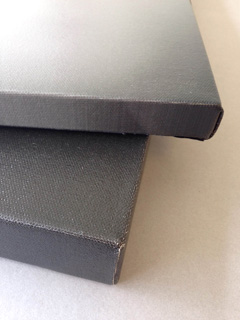
3/4" and 1-1/2" canvas prints
|
| HANGING HARDWARE GUIDELINES
|
 |
Picture framers use a variety of hanging hardware. For each piece, the type is selected based on the size and weight of the framed artwork or canvas print.
- Sawtooth Hooks: These small, zig-zag toothed hooks are hammered or stapled (depending on the style) to the back center of the canvas or frame. They are used only for very small, lightweight pieces, on which a hanger and wire would be unnecessary or difficult to apply. Multiple hooks may be added to long, thin panoramic images.
- D-Ring Hangers: Constructed from a flattened metal piece with a hole looped around a D- or triangle-shaped hook, these hangers are screwed or nailed in place on either side of the canvas or frame, in preparation for the hanging wire. The more spaces for screws, the stronger these hangers are. Hangers with 2 or 3 holes are sometimes refered to as D-strip hangers.
- Steel Plate Hangers: Made from a single strip of steel, these hangs have one or two holes on either side of a raised lip, through which the wire is threaded. Because they have no moving parts, they are stronger than D-ring hangers.
| HANGER STYLE |
MAX. STRENGTH |
| Sawtooth Hook |
20 pounds |
| D-Ring Hanger, single hole |
20 pounds |
| D-Ring Hanger, multi-hole |
40 pounds |
| Steel Plate Hanger, 2-hole |
50 pounds |
| Steel Plate Hanger, 4-hole |
100 pounds |
|
HANGER PLACEMENT
The hangers should be attached 1/3 to 1/4 of the way down from the top of the frame, one on each vertical arm. For instance, if you are hanging a frame or canvas that is 12 inches tall, the hanger (the part where the wire attaches) should be placed between 3 and 4 inches from the top.
HANGING WIRE
Once the hangers have been attached, the hanging wire must be strung between them. Hanging wire comes in various thicknesses that will support different weights, ranging from 15 to 100 pounds. When in doubt, choose the stronger wire.
Softstrand Hanging Wire Strength
- #2 - up to 15 lbs.
- #3 - up to 20 lbs.
- #4 - up to 25 lbs.
- #5 - up to 43 lbs.
- #6 - up to 60 lbs.
- #8 - up to 100 lbs.
Attaching the Wire
- Cut the wire 6 to 8 inches longer than the width of the frame.
- Thread the wire through the loop.
- Wrap it around and pass it through again.
- Wrap the remaining wire (the short end) around the longer end for extra strength.
- Repeat on the other side.
|
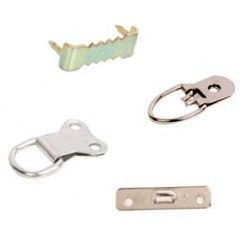
Picture frame hangers

Wrapping the hanging wire
|
| FRAME CONTENT THICKNESS
|
 |
|
When ordering a frame, one thing to keep in mind is the depth of the rabbet. This is a space behind the frame into which your frame contents - glazing, mat, artwork, backing - will be placed.
While there are ways to counteract contents thicker than the frame rabbet, ideally you should have a bit of space left over in the back of your frame once your contents are in place. This allows room for the framer's points (those flat nails that secure the contents) or another backing board for important artwork.
To make sure the rabbet on your chosen frame is deep enough, you will need to know the thickness of the various pieces going into it. If you are putting the frame together at home, don't forget to include the thickness of the art itself in your calculations.
| PRODUCT |
THICKNESS |
| Acrylic Plexiglass (any style) |
3 mm / 0.12 inches |
| Regular or Conservation Matboard |
Approx. 1.3 mm / 0.05 inches |
| Museum Matboard |
Approx 2.5 mm / 0.1 inches |
| Foam core |
5 mm / 0.2 inches |
|
All these thicknesses should be taken into consideration and compared to the rabbet depth of your chosen frame. For instance:
0.12" plexiglass + 0.05" mat + 0.05" artwork + 0.2" foam core = 0.42". Therefore, a frame with a rabbet of 0.5" or more is preferred. 3/8" or 5/16" will be too shallow and the contents will stick out at the back of the frame. These thin frames may also be too fragile to safely support the weight of the contents.
|

Frame contents < rabbet depth
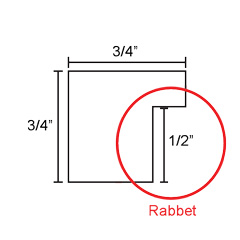
Rabbet depth in frame profile
|
|
When ordering a picture frame, many different factors must be taken into consideration. If you feel overwhelmed by the choices and options, the guidelines in this article may be useful for narrowing down your parameters and speeding up your decision.
Have questions about standard or custom sizes, weights and thickness, or any of our services or products? Don't hesitate to contact us. Our knowledgeable staff is always happy to assist with answers, advice, or suggestions.
|
| Matboard FAQs: |
 |
Q1 : Does my artwork need a mat?
Whether or not to add a mat to your image is entirely up to you. If you intend to sell the artwork or pass it down as a family heirloom, an acid-free mat is a good idea to protect the image from the condensation that may occur on the glass. But if you are simply framing family photographs or an art print, the mat is a purely aesthetic option.
Order online:
Custom-cut matboards
Full sheet, 32x40" matboard
Q2 : What color is your whitest white?
We offer many shades of white mat board. Crystal White is our brightest white.
Order online:
Custom-size mats
Full, 32x40" matboards
Q3 : What is backing board?
Backing board is used to back or mount prints inside a frame.It is slightly thinner than a 4-ply matboard. It
Order online: Backing Boards
Q4 : Do you sell full sheets (32 x 40)?
We currently sell full matboard sheets (32x40") in certain colors.
Order online:
Full, 32x40" matboards
Q5 : What is the purpose of a mat?
Matting is the border that surrounds your art within the frame. Visually, the mat boards provide "breathing room" from any distractions on the surrounding wall including the frame. The other usage of Mat is separating the artwork from the plexi or glass.
Q6 : Should I get an acid-free mat or a regular mat?
Acid- and lignin-free mats guarantee no artwork degradation will occur because of the mat for hundreds of years. If you plan to sell your piece or show it in a gallery, a Museum core mat board is advisable. However, if you are simply framing an inexpensive piece or a print to show in your home, you should be fine with a regular mat.
Even our regular mats are treated with calcium carbonate to keep them acid-neutral for 100 years.
Q7 : How do I choose the best color mat?
A colored mat is a great way to enhance or draw out certain sections of your artwork. At the same time, a colored mat can have a detrimental effect if it does not flatter the artwork colors. Try laying different mats on top of your artwork to help you decide. If no color seems to fit, a mat in one of our many shades of white is always a good choice.
Order online:
Custom-size mats
Q8 : How much of my image will the mat cover?
The mat will cover 1/8" to 1/4" on each side of your image. This overlap is essential to ensure your artwork remains behind the mat and does not fall through. We recommend the default overlap of 1/4", but if your artwork has many important details along the edges that you do not want obscured, we can cut the mat to have an 1/8" overlap.
If your image has a white border around it, do not cut this off prior to matting. We can minimize the amount of overlap on the actual image if there is enough space around the edge.
Q9 : What is the difference between regular, conservation, and museum mat boards?
Regular mat boards are made from wood pulp, treated with an acid-neutralizer that minimizes negative reactions between the mat and artwork. They are our least expensive mat board.
Conservation mat boards have a core of acid- and lignin-free cotton, and a facing of wood pulp paper. They protect the artwork from acid burn and degradation for at least 100 years, and have a mid-range cost.
Museum core mat boards are made entirely of cotton rag paper. They are guaranteed to have no adverse reaction with artwork for hundreds of years. Museum mat boards are the most expensive and the best quality.
Q10 : Do you have more mat options than are on your website?
We do carry other options for mat boards, but they need to be ordered in, and this can delay your order. Please contact us if you require a different mat.
Q11 : How wide should my mat be?
The width of the mat is up to the customer, but we can provide some general guidelines.
For average sized artwork (about 11x14" to 30x20"), the common mat width is 2". If you artwork is smaller, you might consider a 1.75 or 1.5" mat. If you artwork is very large, a 3" or 4" mat may be necessary to ensure an aesthetically pleasing ratio.
Please see our article Measuring for Mats for more information.
Q12 : How do I order a mat board with my frame?
When you select the frame size to order, you will see an option to add "mats" to your order. When you select this, you can choose your mat color. The mat width is the thickness on one side, between the frame and the artwork (generally about 2"). If you are selecting two mats, the reveal is the amount of the bottom mat that will show between the artwork and the top mat.
Q13 : Do you carry different thicknesses of mat boards?
We can make your order with 8 ply mat boards in basic colors, however we do not keep them in stock, so ordering them may delay your order by a few days. We offer a wide selection of colors in the regular 4 ply thickness, and a double mat is a good option if you require a thicker division between plexiglass and image.
Q14 : Can I come into your store to choose a matboard?
If you are located in the Vancouver area, you are welcome to stop by our store and go through our mat samples. Unfortunately, we are an online business and do not have storefronts in other locations.
Q15 : Can I get a mat larger than 32x40 inches?
Unfortunately, our mat boards do not come in a larger size than 32 x 40, so we are unable to accommodate oversize mat orders. Have you considered having your artwork printed with a colored border?
Another option for larger artwork is to purchase a linen liner. Because these are custom made like picture frames, you can order larger sizes. Please note, however, that liners are thicker than matboards, and may require a frame with a deeper rabbet.
Order online: Full, 32x40" Matboards
Q16 : What brand are your mat boards?
Our mat boards are made by Peterboro. This Canadian company has been in the paper-making business since 1902, and their products are manufactured in and distributed from Canada.
Q17 : What is the difference between mat, matt, and matte?
Though "mat" is the most widely recognized spelling, all three words mean the same thing: a rigid paper border that divides the image from the glass and the frame.
"Matte" or "matt" may also refer to a smooth, non-reflective finish.
Q18 : How many different matboard colors do you carry?
We stock 50 regular matboard colors, as well as about 30 conservation and 18 museum core colors. However, we are able to order any color you would like. Contact us if you do not see the color you want on the website. Please remember that ordering a mat we do not have in stock will delay your order a few days.
Order online, or view our full selection in stock: Matboards
Q19 : What is the mat offset?
The offset is the amount that your mat is smaller than your image. This slight overlap ensures your artwork will not fall through your mat. However, you do not need to factor this measurement into your calculations - we will automatically cut your matboard 1/8" to 1/4" smaller on each side than your artwork size.
Q20 : What calculations do I need for ordering a mat?
All you need to know is the size of your artwork, and the width of the mat border (usually about 2" on each side). Both these amounts can be entered in our online form when you place your order.
We will do all other calculations for you, such as the mat offset and the total frame size.
Please see our article, Measuring for Mats for more information.
Q21 : What is the mat window?
The mat window, or mat opening, is the space between the two inner edges of the mat - the hole through which your artwork will show. The mat window is generally 1/4" to 1/2" smaller than your artwork vertically and horizontally. This allows for the mat offset, which overlaps your image 1/8" or 1/4" on each side, keeping the art from falling through the mat.
Q22 : Can I order Custom Cut Frame MatBoards?
Yes, to order click here: Custom Cut MatBoards
Q23 : What is the fifference between 4 ply or 8 ply matbaords?
Ply is the thickness of the matboard. The most common thickness used is 4 ply (around 1/16th of an inch) and double thick matboards are 8 ply or roughly 1/8 inch thick. The higher the number, the thicker and more rigid the board. Ply means a thickness or layer.
|
|
| If you don't find the answer you're looking for here, please contact us. |

Front Side |

Picture framing terms |
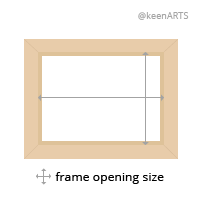
Back Side |
| MatBoard Guide: |
 |
 Single Matboard Sample |
 Double Matboard Sample |
|
Terms:
Top Mat: Top layer of a double mat; It has a larger window, which allows a small border of the bottom mat, called the reveal, to be shown.
Bottom Mat: Optional second layer of matboard used in double matting; The window opening of the bottom mat surrounds the artwork.
Reveal: Width of the bottom mat, normally 1/4", 3/8" & 1/2"
Mat Outer Size: Also known as frame opening size, matches the plexi glass or backing size of the picture frame
Artwork Size: The exact size of the artwork!
Mat Opening Size: Size of the matboard window cut out
|
|
|
Our informative articles on MatBoards:
Choosing the Best Mat Size The article offers helpful tips on selecting the appropriate mat size for your artwork.
Measuring for Mats All about Mat Outer Size, Artwork Size and Mat Opening Size
Choosing Mat Color How to select the best colors of mat fo ryour artwork
All About Mats The article discusses the different materials and attributes of picture framing mats and more!
|
|
© 2002-2025 - KeenART Media Ltd.
|
|
| |
|
